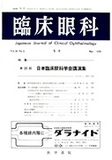Japanese
English
- 有料閲覧
- Abstract 文献概要
昭和42年の臨床眼科学会において,われわれは新しい製品として,シリコンチューブによる人工涙道形成の方法を発表した。人工産物としてシリコンは,生体組織に対し最も反応の少ない物質の一つとして知られている。したがつてシリコンチューブも組織に対する反応が少ないであろうことを期待したものであつた。しかし,当時発表した症例は,臨床経過観察は最長のものでも6カ月にすぎず,人工涙道の永続性に関しては多くの疑問を投げられる状態であつた。その後2年間を経過し,この方法による臨床的効果について一応結論を出しうると考えられるので,以下にその臨床経過を述べるとともに,今後の人工涙道形成について考えてみたい。
使用したシリコンチューブは,高研製の内径2.5mmのものである。チューブ挿入による人工涙道形成の方法は,結膜面で涙湖より涙嚢窩に至り,鼻涙管を経て下鼻道に至るまで,全涙道をシリコンチューブにより形成する方法である。チューブの一端は杯状に開いており,杯状部は,幅2mmの薄いシリコン膜で作られている。この部が結膜面に露出し,下方への脱落を防止する役をなすように作製したのである。
Implantation of the silicone tube of 2.5 mm in inner diameter was performed in 12 cases in order to establish lacrimal passage from theconjunctival sac to the nasal cavity. Three major complications have developed during the two-year followup period: (1) liability to be excluded, (2) occasional chronic infection and (3) fomation of granular tissue at each end of the silicone tube leading to obstruction of the passage. These complications seemed to be de-rived, in part, from the half-exposed and non-fixed method of the present implantation tech-nique. Two years after the surgery, the sili-cone tube was still functioning in situ.
Copyright © 1970, Igaku-Shoin Ltd. All rights reserved.


